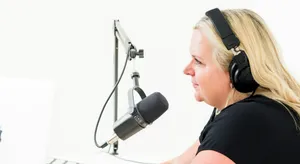Mar 17, 2025
How to Grow Your Podcast Audience Naturally

Ever notice how some podcasts shoot up in popularity while others stay in the shadows? It’s normal to wonder what makes the difference. Growing a show might look tricky, but it’s within reach if you have a clear plan. Lots of hosts ask how to reel in more listeners and keep them coming back. The upside is, there’s no complicated formula. It’s about shaping your content around what people really want to hear and sharing it in ways that connect. With help from tools like #Podpacer, even scheduling or editing tasks can feel simpler. Let’s look at the steps that make all the difference.
Understand Your Target Audience
Many podcasts get recorded and tossed into the world, hoping the right people stumble across them. That can be hit-or-miss. A show that grows steadily usually takes time to pinpoint exactly who’s tuning in. Knowing your listeners shapes everything from topic choices to how you advertise each episode. When you speak directly to the folks who share your passion, you help them feel understood. That sense of connection can be the difference between an occasional listener and a lifelong fan.
Think about it: if someone runs a travel podcast, they’re naturally talking to people who love seeing new places. But maybe those listeners aren’t the rugged backpackers the host expected. They could be families hunting for budget-friendly trips or couples looking for romantic getaways. Spotting these different groups can influence show titles, guest lineups, and even promo styles. It also helps you avoid being too generic and trying to please everyone, which might end up pleasing no one.
By staying aware of changing audience interests, you can adjust your show over time. Maybe fans enjoy glimpses into your personal travel stories or want more interviews with experts. Tracking these shifts isn’t a stretch when you use social media polls, direct feedback, and download stats. Listeners usually say what they like (and don’t) if you invite them to share. Using that info wisely shows you care enough to shape your content around them. It builds trust and loyalty.
Podcasters who treat audience research as an ongoing process often see better results than those who set it and forget it. People evolve, so your show needs to stay flexible. If your listeners rave about short, bite-sized episodes, it might be worth testing a shorter format. That kind of responsiveness can spark even more enthusiasm and inspire fans to share episodes with friends. After all, when people click play, they hope to hear from hosts who truly “get” them.
Identify Who Your Listeners Are
- Check where your downloads come from. Listeners in busy cities might have different interests than those in smaller towns.
- Look at your show’s theme and guess which groups it appeals to. A tech-focused show might pull in young professionals.
- Skim through reviews or comments. Personal stories can reveal listener backgrounds and spark new topic ideas.
Pinpointing different listener segments makes it easier to fine-tune your episodes. If you discover you have a following among parents, you could add tips for kid-friendly travel or flexible routines. Small moves like that might earn you loyal fans who stick around for the long haul.
Research Their Interests and Habits
- Watch which episodes get the highest downloads or longest retention. Those standouts hint at favorite topics.
- Check social media for trending subjects in your niche. Hashtags on Instagram or Twitter can nudge you toward fresh ideas.
- Use polls and surveys. Ask listeners about guest preferences or episode lengths to keep them engaged.
Creating a persona—that mental image of your typical listener—can help you talk naturally, like you’re hanging out with a good friend. That personal vibe builds engagement because people love feeling heard. New listeners might stumble on your show and think, “This was made for me.” That sense of fit spurs them to subscribe, spread the word, and fuel your podcast’s steady rise.
Create Engaging Content
Convincing someone to tune in once is great. Keeping them hooked is what builds real momentum. Engaging content doesn’t always require fancy intros or big guest names. It’s about understanding your audience’s needs, interests, or curiosities, and making each episode feel like a conversation worth having. People gladly recommend content that made them laugh, taught them something, or gave them a fresh perspective.
Swapping up the format can help, too. If you run a parenting show, maybe do a Q&A session this week, then a fun interview with a child psychologist next time. Switching between solo segments, roundtables, and interviews gives your audience variety and keeps you motivated, too. Predictability in release scheduling (like dropping episodes every Tuesday) is good, but adding surprises in content can lead to loyal fans who never want to miss an update.
Audio quality also matters. No one likes straining to hear through fuzzy background noise. You don’t need a high-end studio, just a decent mic and a quiet spot. Clear audio suggests you value your listeners’ time. Even recording in a small corner of your living space can sound good if set up properly. Listeners appreciate that you took steps to ensure a smooth listening experience.
Another smart move is using your audience’s voice to shape future episodes. If people say they love your quirky personal stories, share more. If they suggest shorter episodes, try sprinkling in 15-minute quick tips. You don’t have to rebuild your entire podcast approach, but a little openness to feedback shows them you’re listening, too. That can inspire them to share your show even more.
Focus on Quality Over Quantity
- Choose a mic that offers decent clarity. Even a budget-friendly option can sound fine if you reduce echo and background noise.
- Outline your episodes. A simple plan keeps you on track and ensures richer discussions.
- Release on a schedule. Whether weekly or bi-weekly, consistency lets people anticipate your uploads.
Quality isn’t just about gear. It’s also about the passion and care you show for each topic. That energy can be contagious, bringing people back episode after episode.
Incorporate Listener Feedback
- Ask fans what they’d like to hear next—polls on social media or a quick survey can spark fresh ideas.
- Open each episode with a listener question. It makes them feel part of your show.
- Give a quick shout-out. Acknowledge someone’s comment or review to build personal connections.
People are drawn to hosts who actually care about their opinions. When you weave their suggestions into your plan, you’re creating a community rather than broadcasting at people. That personal touch often sparks a ripple effect, where listeners turn into devoted promoters of your show.
Utilize Social Media for Promotion
Online platforms aren’t just for posting quick thoughts. They’re also a bridge to potential listeners who’ve never heard of your show. A single clip from your newest episode, a behind-the-scenes peak at your recording setup, or a local event announcement can draw attention. Building this habit can strengthen trust and curiosity about what else you’ve got cooking.
Some folks only pop on social media to announce new episodes. That’s a start, but there’s more you can do. Short highlight reels or amusing quotes from your show can catch eyes and encourage friends to tag each other. With the right bite-sized clip, your post could spark a mini-viral moment that funnels people straight to your podcast page.
Choosing which platforms to focus on is also worth thinking about. Facebook might help you reach older or broader audiences, whereas Instagram is suited for visual storytelling. Twitter can be great if you have quick, witty observations to share, and TikTok fits short, punchy videos if your content leans that way. The point is to go where your potential fans are. It’s better to be active consistently on one or two platforms than to spread yourself too thin on all of them.
Consistency applies here as well. Treat your feed like an extension of your podcast’s personality. Keep your branding on point, including the wording style, images, and colors. When people click your profile link, they should see what they’ve been hearing about in your episodes. This clarity builds trust, which can lead to more follows and shares.
Choose the Right Platforms
- Study user demographics. A show about pop culture might shine on TikTok or Instagram.
- Work with your strengths. If you excel at quick humor, Twitter might be your best bet.
- Maintain a consistent theme. Profile photos, banners, and color schemes help people spot your brand instantly.
It’s easy to get lost in endless platform options. Stick to where your audience gathers and keep your posts engaging rather than scattered.
Engage with Your Audience Regularly
- End your posts with a question, prompting replies and sparking real chats.
- Reply to comments and direct messages. That personal response often turns occasional fans into regular listeners.
- Host giveaways or contests. Whether it’s show merch or a guest spot on your next episode, people love a chance to win.
Being visible on social media doesn’t mean living online 24/7. A few minutes each day to check messages or schedule posts is often enough. If people see you as approachable, they’ll be more likely to interact and share your updates with their circles. That kind of engagement can spread quickly, placing your podcast in front of new audiences.
Collaborate with Other Podcasters
Working with fellow hosts can be a major boost. It’s a bit like inviting your circle of friends to someone else’s party—they might end up meeting new people they really connect with. If those new folks like your personality or format, they follow both shows. Collaboration can be a simple guest interview, a shared episode, or even a bigger project with multiple hosts.
Some might worry about competing, but podcasting isn’t a winner-take-all game. Most listeners subscribe to several shows in the same area of interest. It’s pretty common for hosts to swap guest roles, share promotional segments, or brainstorm together without feeling threatened. If done with genuine respect, both sides stand to gain new subscribers who may stick around long after that one crossover episode.
Cross-promotion can act like a friendly endorsement. If another trusted podcaster recommends you, their audience might trust you right away. It’s not just about trading mentions, though. It’s about genuinely boosting each other. When hosts click, the excitement often translates on air, and that vibe can energize both fan bases.
Collaboration also freshens up your routine. If you typically run everything solo, it might feel thrilling to bounce ideas off someone else. Maybe they bring an angle you’ve never considered and open the door to topics your show hasn’t explored. When audiences see you staying open to new ideas, they’re more likely to stay curious and engaged.
Guest Appearances and Interviews
- Seek out experts who bring depth or surprising takes on your topic.
- Ask your guests to share the episode within their networks. That effortless cross-posting can introduce you to new fans.
- Offer to appear on their shows, too. It’s a two-way street, letting you tap into each other’s audiences.
When interviews are done with genuine interest, they can elevate your content and give listeners more reasons to hit play. Essential questions for podcast interviews can help make these conversations more engaging.
Cross-Promotion Strategies
- Swap short ads or quick mentions. A few seconds can be enough to spark curiosity.
- Co-host a segment together. Two voices riffing on a shared theme keep things lively.
- Coordinate posts on social media. Tagging each other multiplies visibility with half the effort.
These steps widen your net, letting you tap into communities that might blend perfectly with your style. A small effort can lead to a big wave of new listeners, particularly if both hosts are excited to share each other’s content.
Repurpose Content for Wider Reach
Each episode is like a treasure chest loaded with nuggets of stories or tips. Once you produce it, you can transform that material into other formats too. Some folks prefer reading a blog post or watching a short clip more than listening to a full hour of audio. Repurposing your show in multiple ways keeps your feed active, even if your next episode is still a week away.
Think of it like cooking a family meal. You can serve soup for dinner, then use leftovers the next day for a new dish. By slicing your episode into smaller clips or turning a discussion into an article, you breathe new life into the content and reach new audiences. It also boosts your visibility on platforms you might otherwise overlook.
Turning a long conversation into a blog post can be perfect for folks who’d rather skim text for key info. If you post it on your site, you might snag an SEO bump, too. YouTube is another space to share your show, even if all you have is audio. Pair it with a static image or simple animation, and you’ll likely reach a group that prefers video-based browsing.
Speaking of efficiency, a platform like #Podpacer can help with transcriptions or quick content repackaging. Handing off that busywork to technology frees you up to focus on creative touches. Instead of redoing everything, you can refine your top highlights and share them in fresh ways.
This approach keeps past episodes alive long after you hit “publish.” A short, catchy snippet from an older show can still resonate today. People scrolling through social feeds love snack-sized bits of entertainment. Once hooked, they might explore the rest of your library, discovering episodes they missed. Repurposing isn’t about repeating yourself. It’s about tailoring your content to different tastes and habits.
Turn Audio into Video Content
- Combine short clips with visuals or captions, then post to YouTube, TikTok, or Instagram Reels.
- Pick standout quotes or surprising moments. Subtitles let people watch on mute.
- Send viewers to the full episode so they can hear more if they’re intrigued.
Many enjoy quick, digestible content. Turning audio into short videos can help you capture those who learn best by watching. Best audio editing software for podcasters can help you create these clips efficiently.
Share Clips on Various Platforms
- Look for funny or insightful moments that could draw people in.
- Tease upcoming episodes so listeners know when to tune in next.
- Schedule posts for a steady flow rather than dumping everything at once.
By recycling your best material, you showcase its value again and again. Whether someone likes reading, watching, or listening, you have something to offer each preference.
Build a Strong Online Presence
A dedicated website can be much more than a landing page. It can become your podcast’s central hub, where listeners catch up on back episodes, read transcripts, and find extra materials. Some rely solely on podcast directories, but maintaining your own domain lets you control the experience. You can highlight important topics, collect emails for a newsletter, or even share photos from events you attend.
It’s like having your own house instead of borrowing someone else’s place. If you want a certain layout or color scheme, you can create it. If listeners love transcripts, you can post those consistently. Over time, your site becomes an extension of your brand, letting people get closer to your content in a way directories don’t always allow.
Newsletters are another option for staying in touch with fans. People who sign up are saying, “I want to hear more about what you do.” That’s a golden chance to send show updates, behind-the-scenes snapshots, or even short stories you didn’t squeeze into the podcast. It’s a direct channel that sidesteps the noise of social media. By appearing in their inbox, you remind folks to queue up your latest release.
Clarity is key. If someone stumbles onto your site, they should instantly see what your show is about. Putting a short summary at the top helps them decide if they want to dive in. Showcasing your most recent episodes, with short descriptions that reveal the topics, can spur them to hit play right there. Adding a contact form might bring in feedback or potential guests who want to reach out directly.
Develop a Dedicated Podcast Website
- Embed an audio player so people can listen instantly.
- Offer transcripts to boost SEO and help folks who prefer reading.
- Share any big news or appearances you have coming up. Let fans meet you in person if possible.
This site can be your show’s personalized zone. It reflects your personality, fosters a deeper bond, and keeps all your content in one accessible spot.
Create a Newsletter for Updates
- Make sign-up quick and easy, so folks aren’t scared off by too many steps.
- Include mini tips or anecdotes exclusive to subscribers to keep them feeling special.
- Ask for replies or topic suggestions in each email. That two-way street can help shape your next episodes.
When fans see your dedication, they’ll trust you as a reliable source. If they like what they find, they’re more likely to stick around, share your show, and champion your brand.
Conclusion
Reaching more ears isn’t about big celebrity names or secret formulas. It’s about showing steady effort in multiple areas. That might mean identifying your audience’s interests, polishing your SEO, making social media part of your routine, and weaving in a website or newsletter. If you keep at it, new folks will start tuning in, chiming in with feedback, and nudging buddies to give you a try.
Some might think a huge budget is required, but it really comes down to having a strong vision, a genuine tone, and being open to minor tweaks. Tools like #Podpacer can help with production and sharing tasks so you can spend more energy on content itself. Even if you don’t have many fancy resources, a consistent spark of passion will keep people coming back for more. That positive energy often inspires listeners to stay connected and keep spreading the word.
Picture it as building a campfire. At first, there’s only a flicker, but every new idea—like adjusting episode titles, joining forces with another podcaster, or hosting a social giveaway—adds more fuel. Slowly, you turn that spark into an inviting glow. People wander over, like what they hear, and invite their friends. That’s how a small podcast can blossom into a buzzing community over time.
Nobody expects dramatic leaps overnight. It might take months or even a year or two for numbers to shift in a big way. But each new subscriber can carry your name to a wider circle. Treat listeners like valuable guests, and keep seeking ways to enrich their experience. A little warmth and consistency can go a long way toward drawing in fresh faces who end up sticking around for your entire catalog.
Frequently Asked Questions (FAQ):
• How do I get 1000 listeners for my podcast? To reach 1000 listeners, focus on content that resonates with your target audience, promote your episodes on social media, collaborate with other podcasters, and interact with your fans. Engaged supporters often spread the word, which speeds up growth. Learn more about podcast promotion services that can help accelerate your growth.
• How to grow your audience podcast? Improving your show’s SEO, posting episodes regularly, leveraging social platforms, and adding your show to various directories can help you expand your reach. Creating a genuine community vibe also leads to steady audience growth.
• How much does a podcast with 1000 listeners make? Earnings vary widely. With 1000 regular listeners, you could earn through sponsorships, affiliate deals, or listener donations. Many podcasters in that range see around $10 to $50 per episode, depending on how actively they monetize.
• How long does it take to grow a podcast audience? There’s no fixed timeline for building an audience. Some shows hit a stride in a few months, while others take a year or more to gain traction. Consistency, strong content, and regular engagement are key in the long run.
Related Posts
See All Posts

Social Media for Podcasts: How to Build and Engage Your Audience
Podcasts have become part of everyday routines, offering stories and insights with just a tap. But with so many choices out there, finding t


Mastering Podcast SEO Techniques: A Comprehensive Guide
In a world where podcasts keep growing, getting noticed can feel like a climb. There's a bright side, though. [Learn more about boost podcas


Top Podcast Promotion Strategies for 2025
Plenty of podcast creators hope to stand out in a sea of audio content. With over two million shows available, it's essential to find new wa
No one knows your podcast like Podpacer
Podpacer is the best way to handle your podcast production. Manage your guests, research and plan your interviews, write social media content with one click, all in one place.


